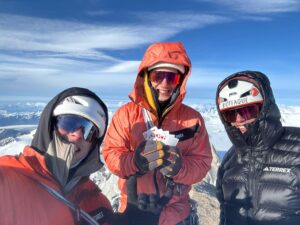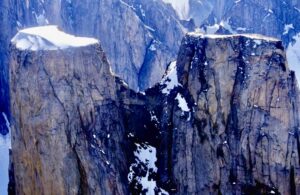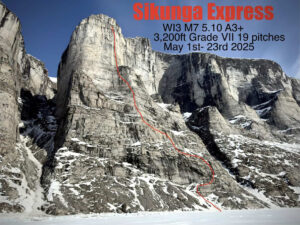He is one of the most iconic characters in the big wall scene in general and Patagonia in particular. Sean Villanueva O’Driscoll is a multi-awarded climber, artist, reflective observer, and polyglot who feels at home anywhere there are walls to climb. Somehow, the climber has managed to make that combination of personality traits fit in harmony with the savage atmosphere of the Patagonian spires.
O’Driscoll made time before hitting some early-season ice around Banff for a chat with ExplorersWeb. He had come to the Canadian Rockies for the Banff Mountain Film Festival, where he and his partners told in words (and song) about their first free ascent of Riders on the Storm on Torres del Paine.
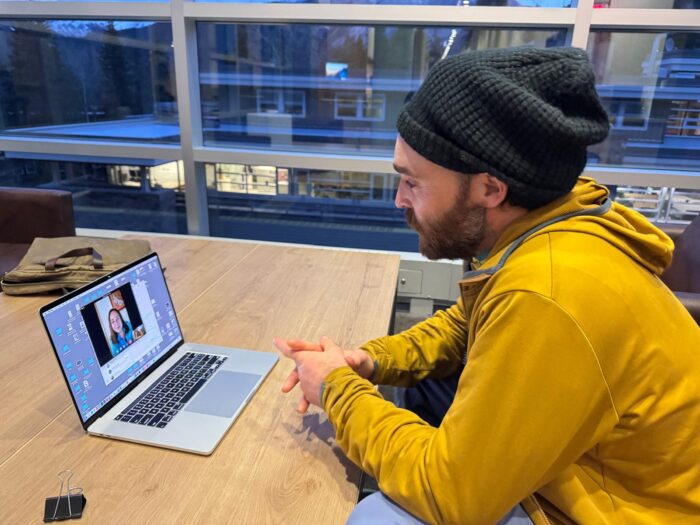
Sean Villanueva O’Driscoll during the interview. Photo: Jerry Kobalenko
Born in flat Belgium 43 years ago, O’Driscoll unsurprisingly began his career in a climbing gym and then sports climbing on natural rock: bouldering, crags, then multi-pitch. He moved to western Europe, from Spain to the Alps, then progressed to big walls around the world, from Yosemite to the Himalaya. Yet he is most often associated with Patagonia.
Dragged to Patagonia
“It’s just a powerful place, the weather, the rough scenery…There, you feel so small and insignificant…It just dragged me, and I can’t stop coming back there.”
O’Driscoll cited an old Patagonian legend: “If you eat Calafate berries [Berberis microphylla, a symbol of Patagonia and, according to recent studies, a superfood], even just one, you’ll have to return to Patagonia for the rest of your life, and I did have some!”
O’Driscoll visited Patagonia for the first time in 2006 on his first alpine big wall expedition. On that occasion, he did the first repetition of Riders on the Storm on the central tower on Torres del Paine with regular climbing partner Nico Favresse, as well as Mike Lecomte and Favresse’s brother, Olivier.
The mythical route, opened by Kurt Albert, Bernd Arnold, Norbert Baetz, Peter Dittrich, and Wolfgang Guellich in 1991, left its mark on O’Driscoll. He wanted to return to attempt the first free climb of its 38 pitches. To its overall grade of VI 5.12d (European 7c) A3, you need to add a notable exposure to rockfall.
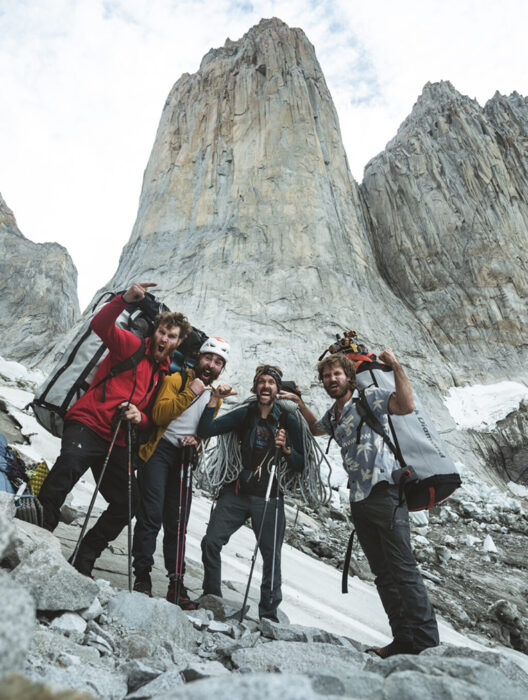
The ‘riders’ about to tackle the storm at Torres del Paine. Photo: Drew Smith
Siebe Vanhee had unsuccessfully tried to free-climb it the previous year, but it was when the Belgian trio of Vanhee, O’Driscoll, and Nico Favresse joined forces in 2024 — with photographer Drew Smith as a fourth — that they finally succeeded after 18 days on that wild Patagonian wall.
Enjoying the storm
How do you ride out the famously heinous Patagonian weather? It’s not about fun or the challenge of bagging a first. It’s something personal. In addition to skills and endurance, such a climb is about attitude.
“Out of the 18 days we spent on the wall, we could only climb six,” O’Driscoll explained. “The rest of the time was spent sitting in the portaledges, hit by snow and wind. You have to be comfortable in that situation, and if you don’t manage to enjoy yourself, you will not be able to continue.”
Conditions were also extremely hard during the climbing days.
“The wind is blowing, it is snowing, there’s ice on the holds, your fingers and feet hurt or get completely numb, so if you’re just there for the performance, to achieve the first free climb, you’re not going to do it. You have to be patient and enjoy the process.
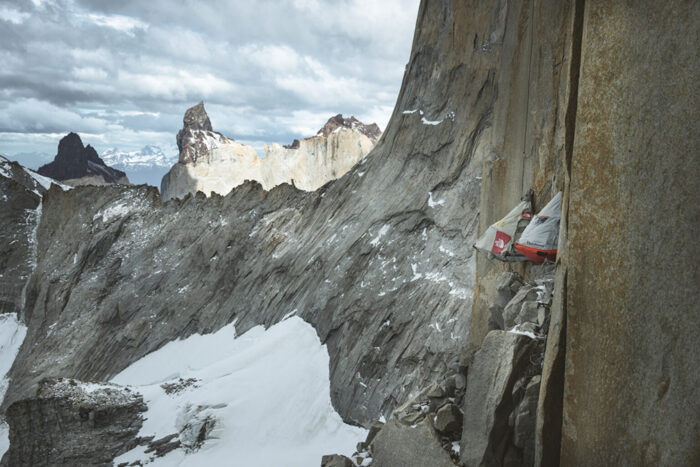
Long days inside the portaledges. Photo: Drew Smith
A privilege
“In the end,” he added, “it is a choice: you have to choose to enjoy, understand that it is also a huge opportunity, a privilege just to be there on the portaledge, in that incredible place. Sure, it’s scary sometimes, but it is also incredible to be out there.”
He believes that the key is accepting the weather and the conditions is simply making the best of it.
To help time pass, the climbers read, chatted, and played music. Luckily, they are very familiar with each other, and O’Driscoll said they never quarrel on a climb. Photographer Drew Smith pointed out after the expedition, “The summit was reached far before we stood on top because of the positive energy of the team.”
Yet winds over 100kph eat up a lot of that positive energy.
“There was one night when the wind was so, so high, and the portaledge was shaking and banging all night long that it was impossible to sleep,” O’Driscoll recalled. “It was like heavy turbulence. On that occasion, in addition to securing the portaledge on top, we also had to tie the floor to the wall. Otherwise, it would just fly away in the wind like a flying carpet.”
Music
On a route named after a song by The Doors, the sound of music resonated while O’Driscoll and Favresse were there.
“It’s a very special place to play music, and our instruments have become part of our climbing gear,” O’Driscoll said. “Music is a great resource to lift up the spirits. When you are playing music, you are there expressing yourself, learning, practicing, and communicating with the others. You are not just waiting.”
Asked if music would be less important if Patagonia had better weather and they weren’t tentbound as often, O’Driscoll reflected: “I [still] think it would help with the uncertainty and the difficulties ahead. Yet, playing music is not something we planned as mental training or anything, it’s just something we started doing to pass the time, and turned out to be amazing.”
A lucky weather window
After Riders on the Storm, O’Driscoll went to El Chalten to rest and visit friends. “After such an exhausting expedition, I feel like a wreck and need time to recover,” he said. “I don’t think I could do several major climbs back to back.”
However, on this occasion, a rare good spell of Patagonian weather was too tempting. “I recovered at El Chalten, and then I saw this weather window and said, wow…You know, in Patagonia, you don’t get many weather windows like this one, so when one happens, you get ready quickly,” he said.
On February 22-25, he soloed the Skyline traverse of the four towers of Torres del Paine, following the jagged outline’s double-M shape.
Before the climb, O’Driscoll had modest expectations. “I thought ok, worst-case scenario, I’ll just go for a walk and turn around if conditions are not right,” he said. “But I got to the base, and it looked good, so I thought I could climb one pitch and see how it went, so I did one pitch, and then two, and then three pitches, and then I ended up doing the whole traverse.”
Filming while climbing
Despite the hardships of Riders on the Storm, Drew Smith managed to get enough material to put together a documentary of the climb. It will be released soon.
The rigors of filming somehow didn’t get in the way of the team’s connection to the mountain.
“There is something amazing in the way a good film can let us climbers share our story, the experience, and the places,” O’Driscoll said. “In addition, Drew never interfered with the climb or with what we did. In fact, he filmed but he was also part of the team, climbing and dealing with the gear like the rest of us.”
O’Driscoll recalled a veteran climber commenting during an event how “if you don’t write books, you are a nobody.” That was the case for his generation. “So perhaps now, it’s the same with movies,” laughed O’Driscoll. “If you don’t do films, you’re a nobody. But well, that’s fine with me, I’m a climber.”
A ‘lifer’
Two days before the interview, O’Driscoll had listened to a Banff event featuring Jim Donini. At 81 and with an impressive climbing career behind him, Donini was still doing first ascents in an obscure part of Patagonia. Not as technical as he used to do, but that didn’t matter to him. Donini described himself as “a lifer.”
O’Driscoll says he feels the same. “I love what I do, and I feel privileged. As long as I can do it and keep loving it, I have no desire to do anything else…As time goes by, I know I will take pleasure in doing 5.9 or just scrambling or hiking…I don’t have to be a world-class climber, but just enjoy what I can do.”
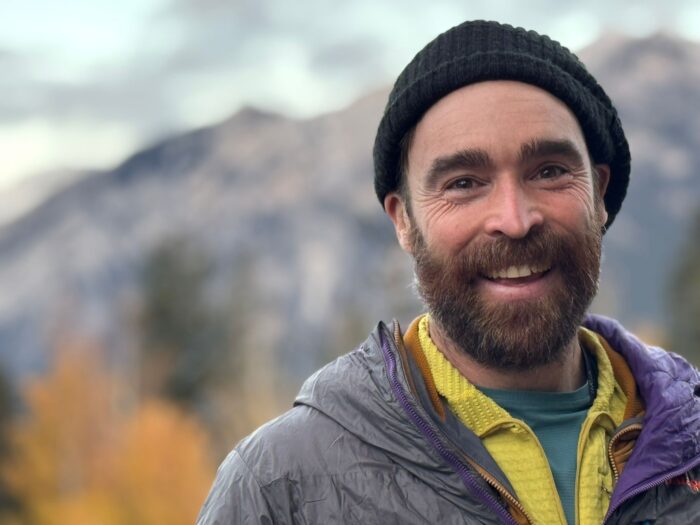
Sean Villanueva O’Driscoll at the Banff Mountain Film Festival, Canada. Photo: Jerry Kobalenko

